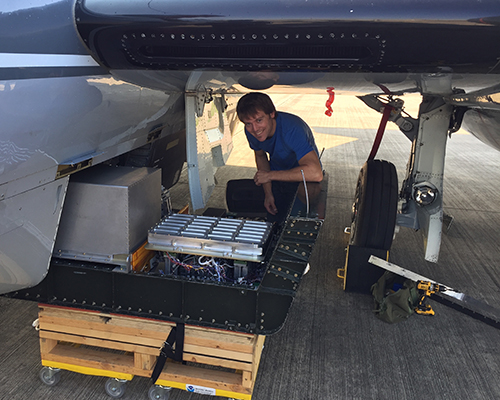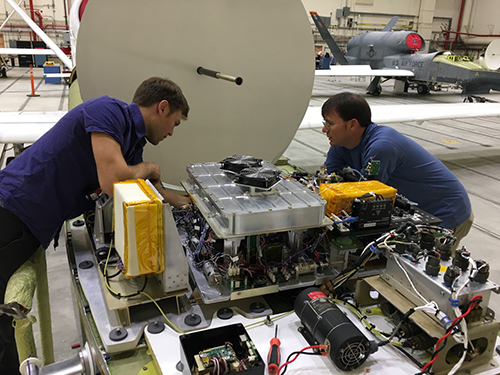Atmospheric Composition & Chemical Processes: Instruments
Laser Induced Fluorescence Instrumentation for Sulfur Dioxide (SO2-LIF)

The laser induced fluorescence (LIF) technique for measuring SO2 at parts per trillion mixing ratios was developed by Andrew Rollins at NOAA CSL starting in 2015. This project leverages recent advances in fiber laser technology to make much more practical the operation of tunable deep-ultraviolet lasers outside of the laboratory and on many mobile platforms. This technique can provide sensitive and specific detection of SO2 at mixing ratios typically found throughout the troposphere and lower stratosphere with high time resolution.
Currently, two such instruments have been built and are ready for deployment on aircraft. One instrument is optimized for integration on the NASA WB-57F in an unpressurized pallet, and the second instrument is designed for 19" rack-mount installation on platforms such as the NASA DC-8. The NASA WB-57F instrument has been used to perform the first survey of SO2 in the tropical upper troposphere and lower stratosphere (UT/LS). These measurements provide an important constraint on the role of SO2 in new particle formation and growth in the UT region, and in the importance of SO2 transport into the stratosphere as a source of stratospheric aerosol.
Most recently we have been involved in studying the chemistry of dimethyl sulfide in the marine boundary layer and oxidation chemistry of sulfur in fire plumes. In the coming years we plan to be involved in continuing to investigate sulfur chemistry in the marine boundary layer (NOAA AEROMMA mission), and in SO2 transport into the LS via the Asian Summer Monsoon anticyclone (NASA/NSF ACCLIP mission).

- Detection limit: 5 pptv / 1 second, 2 pptv / 10 seconds
- Accuracy: +/- 10% + 1 pptv
- Airborne time response: 5 Hz
- Atmospheric Emissions and Reactions Observed from Megacities to Marine Areas (AEROMMA) 2023, NASA DC-8
- Stratospheric Aerosol processes, Budget and Radiative Effects (SABRE) 2022, NASA WB-57
- Asian Summer Monsoon Chemical & CLimate Impact Project (ACCLIP) 2021, NASA WB-57
- Fire Influence on Regional to Global Environments and Air Quality (FIREX-AQ) 2019, NASA DC-8
- Atmospheric Tomography Mission (ATom)-4 2018, NASA DC-8
- HOPE-East Pacific Origins and Characteristics of Hurricanes (EPOCH) 2017, NASA Global Hawk UAS 2017
- Pacific Oxidants, Sulfur, Ice, Dehydration, and cONvection (POSIDON) 2016, NASA WB-57F
- Volcano-plume Investigation Readiness and Gas-phase and Aerosol Sulfur (VIRGAS) 2015, NASA WB-57F
Rickly, P. S., Xu, L., Crounse, J. D., Wennberg, and Rollins, A. W., Improvements to a laser-induced fluorescence instrument for measuring SO2: Impact on accuracy and precision, Atmospheric Measurement Techniques, doi:10.5194/amt-2020-435, 2020.
Rollins, A. W., Thornberry, T. D., Atlas, E., Navarro, M., Schauffler, S., Moore, F., Elkins, J. W., Ray, E., Rosenlof, K., Aquila, V., and Gao, R.-S., SO2 Observations and Sources in the Western Pacific Tropical Tropopause Region, Journal of Geophysical Research, doi:10.1029/2018JD029635, 2018.
Rollins, A. W., Thornberry, T. D., Watts, L. A., Yu, P., Rosenlof, K. H., Mills, M., Baumann, E., Giorgetta, F. R., Bui, T. V., Hoepfner, M., Walker, K. A., Boone, C., Bernath, P. F., Colarco, P. R., Newman, P. A., Fahey, D. W., and Gao, R.-S., The Role of Sulfur Dioxide in Stratospheric Aerosol Formation Evaluated Using In- Situ Measurements in the Tropical Lower Stratosphere, Geophysical Research Letters, doi:10.1002/2017GL072754, 2017.
Rollins, A. W., Thornberry, T. D., Ciciora, S. J., McLaughlin, R. J., Watts, L. A., Hanisco, T. F., Baumann, E., Giorgetta, R. F., Bui, T. V., Fahey, D. W. and Gao, R.-S., A laser-induced fluorescence instrument for aircraft measurements of sulfur dioxide in the upper troposphere and lower stratosphere, Atmospheric Measurement Techniques, 10.5194/amt-9-4601-2016, 2016.